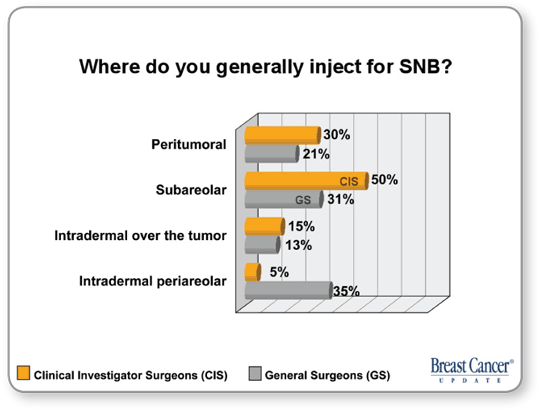|
|
||||||||||||||
![]()

FACULTY COMMENTS
![]() DR DIXON: The science behind injection site location for lymphatic
mapping is not clear. Studies suggest that if you inject technetium in
the subareolar region and blue dye around the tumor, the injections
drain to the same sentinel nodes. I’m not convinced utilizing two injection
sites provides benefit. Furthermore, I find injecting peritumorally
to be messy when performing surgery, especially when I want to see
what’s going on, to see the bleeding. When I first started, I injected
peritumorally but have since converted to subareolar.
DR DIXON: The science behind injection site location for lymphatic
mapping is not clear. Studies suggest that if you inject technetium in
the subareolar region and blue dye around the tumor, the injections
drain to the same sentinel nodes. I’m not convinced utilizing two injection
sites provides benefit. Furthermore, I find injecting peritumorally
to be messy when performing surgery, especially when I want to see
what’s going on, to see the bleeding. When I first started, I injected
peritumorally but have since converted to subareolar.
Subareolar injection is easy, straightforward and more commonly practiced, which is especially important when considering the issue of so many impalpable tumors. The radiologist injects the radioisotope around the tumor, and evidence shows this works quite well.
Conversely, other studies have found that “The deep aspects of the breast and the parenchyma drain differently to the subareolar region.” However, we’ve done a fairly large study on subareolar injection and have shown highly effective sentinel node mapping with a low false-negative rate.
| Table of Contents | Top of Page |
Editor's Note
State of the art 2008
Neil Love, MD
Slides and Faculty Comments
Sentinel Lymph Node Biospy (LSNB) Relative to Neoadjuvant Systemic Therapy
Sentinel Node Biopsy Injection Site
Partial Breast Irradiation (PBI)
Genomic Assays: Prediction of Benefit from Chemotherapy
Hormone Receptor-Positive Breast Cancer
A CME Audio Series and Activity